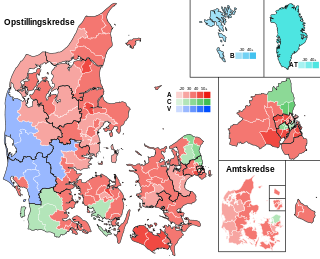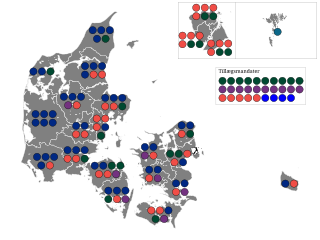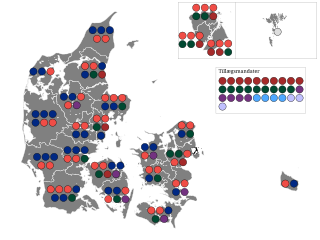
General elections were held in Denmark on 8 September 1987. Although the Social Democratic Party remained the largest in the Folketing with 54 of the 179 seats, the Conservative People's Party-led coalition government was able to continue. Voter turnout was 87% in Denmark proper, 69% in the Faroe Islands and 45% in Greenland.

General elections were held in Denmark on 10 January 1984, after the opposition voted against the government's state budget bill. Although the Social Democratic Party remained the largest in the Folketing with 56 of the 179 seats, the Conservative People's Party achieved its best-ever result, gaining 16 seats. The coalition partners Venstre and the Christian People's Party also increased their representation, although the fourth government party, the Centre Democrats, lost seven of their 15 seats. Overall the coalition won three more seats, and Poul Schlüter continued as prime minister.

General elections were held in Denmark on 23 October 1979. The Social Democratic Party remained the largest in the Folketing, with 68 of the 179 seats. Voter turnout was 86% in Denmark proper, 65% in the Faroe Islands and 50% in Greenland.

General elections were held in Denmark on 15 February 1977. The Social Democratic Party remained the largest in the Folketing, with 65 of the 179 seats. Voter turnout was 89% in Denmark proper, 63% in the Faroe Islands and 70% in Greenland.

General elections were held in Denmark on 21 September 1971 and in the Faroe Islands on 5 October. The Social Democratic Party remained the largest in the Folketing, with 70 of the 179 seats. Voter turnout was 87% in Denmark proper, 57% in the Faroe Islands and 52% in Greenland.

General elections were held in Denmark on 23 January 1968. The Social Democratic Party remained the largest in the Folketing, with 62 of the 179 seats. Voter turnout was 89% in Denmark proper, 57% in the Faroe Islands and 56% in Greenland. They were the last elections in which the old counties were used as constituencies.

General elections were held in Denmark on 22 September 1964. The Social Democratic Party remained the largest in the Folketing, with 76 of the 179 seats. Voter turnout was 86% in Denmark proper, 50% in the Faroe Islands and 49% in Greenland. They were the first elections with the new electoral threshold of 2%.

Folketing elections were held in Denmark on 26 April 1920, except in the Faroe Islands, where they were held on 20 May. The election campaign was the most aggressive and bitter in Denmark in the 20th century. Voter turnout was 80.6% in Denmark proper and 58.8% in the Faroe Islands.

Folketing elections were held in Denmark on 6 July 1920, except in the Faroe Islands, where they were held on 3 August. The result was a victory for Venstre, which won 51 of the 140 seats. Voter turnout was 74.9% in Denmark proper and 46.4% in the Faroe Islands.

Folketing elections were held in Denmark on 21 September 1920, except in the Faroe Islands, where they were held on 30 October. They were the first in which South Jutland County participated since the Schleswig Plebiscites and the return to Danish rule, and the total number of seats in the Folketing was increased from 140 to 149. The result was a victory for Venstre, which won 51 of the 149 seats. Voter turnout was 77.0% in Denmark proper and 56.2% in the Faroe Islands.

Folketing elections were held in Denmark on 11 April 1924. The result was a victory for the Social Democratic Party led by Thorvald Stauning, which won 55 of the 149 seats. Voter turnout was 78.6% in Denmark proper. In the Faroe Islands constituency there was only one candidate, who was returned unopposed.

Folketing elections were held in Denmark on 2 December 1926, except in the Faroe Islands where they were held on 20 December. The Social Democratic Party remained the largest in the Folketing, with 53 of the 149 seats. Voter turnout was 77.0% in Denmark proper and 40.2% in the Faroes.

Folketing elections were held in Denmark on 24 April 1929, except in the Faroe Islands where they were held on 29 May. The Social Democratic Party remained the largest in the Folketing, with 61 of the 149 seats. Voter turnout was 79.7% in Denmark proper and 58.0% in the Faroes. Social Democrat Thorvald Stauning returned to the Prime Ministership by forming a coalition government with the Social Liberals, a position he would hold until 1942.

Folketing elections were held in Denmark on 16 November 1932, except in the Faroe Islands where they were held on 12 December. The Social Democratic Party remained the largest in the Folketing, with 62 of the 149 seats. Voter turnout was 81.5% in Denmark proper and 59.2% in the Faroes.

Folketing elections were held alongside Landsting elections in Denmark on 30 October 1945, except in the Faroe Islands where they were held on 20 November. The Social Democratic Party remained the largest in the Folketing, with 48 of the 149 seats. Voter turnout was 86% in Denmark proper and 57% in the Faroes.

Folketing elections were held in Denmark on 22 October 1935, except in the Faroe Islands where they were held on 11 November. The Social Democratic Party led by Prime minister Thorvald Stauning remained the largest in the Folketing, winning 68 of the 149 seats. Voter turnout was 80.7% in Denmark proper and 55.4% in the Faroes. It was in this election that the Social Democrats used the famous slogan "Stauning or Chaos".

Folketing elections were held in Denmark on 3 April 1939, except in the Faroe Islands where they were held on 19 April. They followed a dissolution of both chambers in order to call a referendum on changing the constitution. The referendum was held on 23 May but failed due to a low voter turnout. The result of the elections was a victory for the Social Democratic Party, which won 64 of the 149 seats. Voter turnout was 79.2% in Denmark proper and 47.8% in the Faroes.

Folketing elections were held in Denmark on 23 March 1943 alongside Landsting elections, except in the Faroe Islands where they were held on 3 May. They were the first and only parliamentary elections held during the German occupation, and although many people feared how the Germans might react, they took place peacefully.

Folketing elections were held in Denmark on 28 October 1947, except in the Faroe Islands where they were held on 18 February 1948. The Social Democratic Party remained the largest in the Folketing, with 57 of the 150 seats. Voter turnout was 86% in Denmark proper and 60% in the Faroes.

Folketing elections were held alongside Landsting elections in Denmark on 21 April 1953, except in the Faroe Islands where they were held on 7 May. The Social Democratic Party remained the largest in the Folketing, with 61 of the 151 seats. Voter turnout was 81% in Denmark proper but just 20% in the Faroes.





















